|
|
|
There are several sources for streamline struts and slip ons for tubular struts, but weight constraints pretty much rule them out. I followed up several ideas about how to make fairings, but in each case I was not able to come up with a workable method that I felt would ensure success. Then one day I spied some unused blue foam insulation (two pounds per cubic foot) in my shop. I laid out the profile shown above. I printed out the pattern, glued it to the foam and tried to cut out fairing nose and tail profile shapes. |
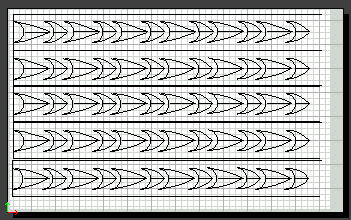 Early attempts lead to the layout shown to the left. The back side of the print out was sprayed with adhesive and the pattern was wall papered onto the blue foam. Cuts were make along each horizontal line. Using a table scroll saw, the profiles were cut from the sticks starting at the left end. This method saves material and lets one keep their fingers away from the saw blade.
Early attempts lead to the layout shown to the left. The back side of the print out was sprayed with adhesive and the pattern was wall papered onto the blue foam. Cuts were make along each horizontal line. Using a table scroll saw, the profiles were cut from the sticks starting at the left end. This method saves material and lets one keep their fingers away from the saw blade.
|
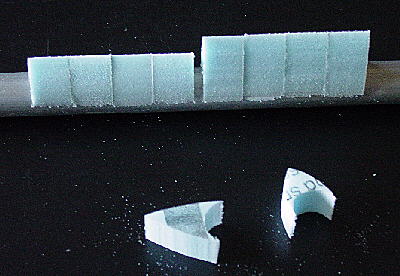 The strut tube free length is 50 inches long, and the foam is .75 inch thick, so about 270 nose and tail profile sets must be made. Two inch thick foam would reduce the number of pieces to 100. Two inch thick foam would require greater scroll saw blade alignment accuracy and much greater care in feeding the foam into the blade while maintaining good contact with the table.
The strut tube free length is 50 inches long, and the foam is .75 inch thick, so about 270 nose and tail profile sets must be made. Two inch thick foam would reduce the number of pieces to 100. Two inch thick foam would require greater scroll saw blade alignment accuracy and much greater care in feeding the foam into the blade while maintaining good contact with the table.
|
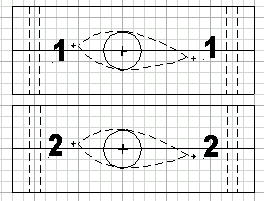 The next problem is how to locate the foam fairing pieces on the existing struts. One wishes to ensure that the fairings generate neutral lift and minimum drag at cruise. This angle has been found to be six degrees from the horizontal and in the direction of flight for the FireFly.
The next problem is how to locate the foam fairing pieces on the existing struts. One wishes to ensure that the fairings generate neutral lift and minimum drag at cruise. This angle has been found to be six degrees from the horizontal and in the direction of flight for the FireFly.
Two wood alignment fixtures or clamps were made as shown to the left. Small holes are drilled ahead and behind the profile, so that, sight strings can be used to align the foam pieces. |
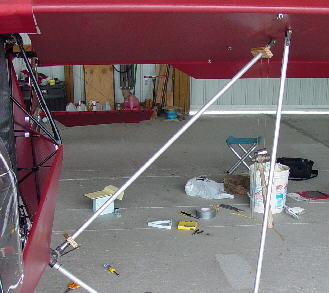 One of the struts was unbolted from the lower support and swung out of the way. The one fixture was placed around the remaining strut as close to the lower support as possible. The second fixture was placed up next to the upper attachment. Fish line was threaded through each hole starting up under the wing and passed through the corresponding hole next to the landing gear and tied off. The free end under the wing was tied to a heavy object, in this case, a hammer and a breaker bar handle. These weights maintain string tension and the strings act as a sight line guides for leading and trailing fairing piece placement.
One of the struts was unbolted from the lower support and swung out of the way. The one fixture was placed around the remaining strut as close to the lower support as possible. The second fixture was placed up next to the upper attachment. Fish line was threaded through each hole starting up under the wing and passed through the corresponding hole next to the landing gear and tied off. The free end under the wing was tied to a heavy object, in this case, a hammer and a breaker bar handle. These weights maintain string tension and the strings act as a sight line guides for leading and trailing fairing piece placement.
|
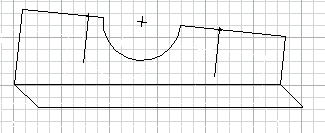
To align the fixtures properly, one cannot just level the fixtures as shown in the above drawing. The struts are not square to the level flight air flow. A small gage was made from aluminum house flashing, and it was stuck to the top of a level with double sided sticky tape. The fixtures were rotated until the level bubble centered and the level parallel to the fight path and with the upper surface touching the strings. |
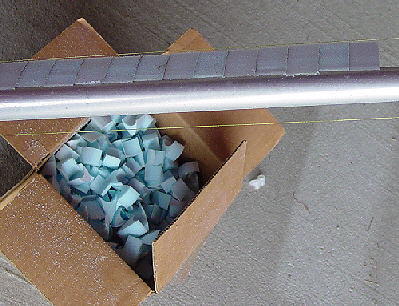 The paper pattern was not removed from the foam so that the profile center line would help with proper alignment. The fixture and strut assembly was set up on one end so that all of the leading and trailing fairing pieces could be glued into place. Quick setting epoxy was used to fix the foam to the strut surface and foam to paper pattern. The fish line and location fixtures were removed. Additional full and parts of fairing pieces were glued to the strut to completely cover all tube area that is not infringed upon by steel tangs or fittings. The strut was ready to be removed and taken home for finishing.
The paper pattern was not removed from the foam so that the profile center line would help with proper alignment. The fixture and strut assembly was set up on one end so that all of the leading and trailing fairing pieces could be glued into place. Quick setting epoxy was used to fix the foam to the strut surface and foam to paper pattern. The fish line and location fixtures were removed. Additional full and parts of fairing pieces were glued to the strut to completely cover all tube area that is not infringed upon by steel tangs or fittings. The strut was ready to be removed and taken home for finishing.
|
 Temporary wing supports were made out of 2x2's, a couple of long nails and two pieces of wall paneling. The 2x2's were cut to about 53 inches long. To keep the upper end of the 2x2 from damaging the wing fabric, a six inch square was cut from scrap wall paneling. A hole was drilled in the middle. A large nail was passed through the hole and hammered into the end of the 2x2, leaving about two inches of the nail protruding above the paneling. This nail was slipped into the wing folding hole and the bottom of the 2x2 slid into place. With the wheels chocked, the struts were removed.
Temporary wing supports were made out of 2x2's, a couple of long nails and two pieces of wall paneling. The 2x2's were cut to about 53 inches long. To keep the upper end of the 2x2 from damaging the wing fabric, a six inch square was cut from scrap wall paneling. A hole was drilled in the middle. A large nail was passed through the hole and hammered into the end of the 2x2, leaving about two inches of the nail protruding above the paneling. This nail was slipped into the wing folding hole and the bottom of the 2x2 slid into place. With the wheels chocked, the struts were removed.
|
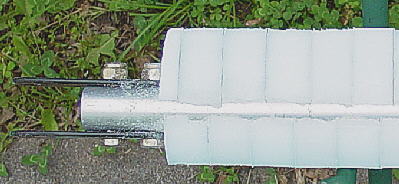 A fine/medium drywall sanding sponge was used to smooth out the foam surfaces. Then the foam was sealed with poly-eurothane varnish. This toughens the fairing trailing edge so that it will support a sharp edge.
A fine/medium drywall sanding sponge was used to smooth out the foam surfaces. Then the foam was sealed with poly-eurothane varnish. This toughens the fairing trailing edge so that it will support a sharp edge.
|

|
|
A fixture was made (a third hand is needed) to hold the strut so that the foam surface could be covered with fabric, varnished and painted. On the right end the round strut passes through a hole that can be pinched and acts as a friction brake. This lets one rotate and hold the strut in any position.
|
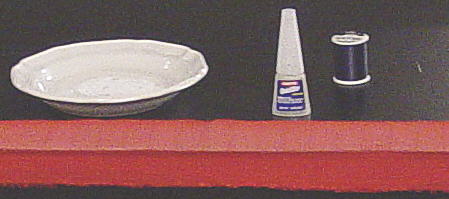
After sealing the foam surface, polyester fabric (chiffon) was tacked to the fairing trailing using acrylic cement (crazy glue) starting at one end and tacking every foot or so. The fabric was stretched so that it remains in tension as one moves from one tack point to the next. To hurry the process, a little baking soda was brushed onto the wet glue and fabric. One needs to leave about and inch of excess material on the edge. The fairing was flipped over onto the opposite side and the fabric was pulled over the front to the rear of the top side, and the tacking process was repeated. In doing so, the tacking should start in the middle and pull all slack out of the fabric toward the trailing edge. During all other tacking, tension was maintained to the back and away from the center as tacks were made. This kept the fabric from dimpling. The trailing edge excess fabric was trimmed away leaving about and inch to hold on to while sewing the trailing edges together. Using a quarter inch stitch, the trailing edge was hand sewn with back and forth simple stitch. If a dimple was found, a drop of crazy glue was used to smooth it out. One inch wide disposable sponge brush was used to apply poly-eurothane varnish to the fabric. After the varnish set, small curved scissors were used to trim the excess fabric from the stitch line. The strut was hung up and two coats of exterior latex house paint, cut fifty percent with windshield wiper fluid, was brushed onto the fabric. This whole process was repeated until all struts had been modified. The original struts with the two upper tangs with bolts and nuts weighed 14.8 ounces before mounting the fairings. The foam, poly-eurothane varnish (two coats), and two coats of latex paint add three ounces per strut. So the total FireFly weight gain was 12 ounces. If I had to do it over again, I would not use the varnish, and I would use uncut latex to fix the cloth to the foam. Less material would be used with an improved surface finish. Although the chiffon material is very strong and light, it has a large open weave that is difficult to fill or seal. Next time I will look for a tighter woven, thinner material. One unexpected benefit has been that the fairings stiffened the struts, and so, they do not strum during flight, rattle while taxiing or vibrate at low engine speeds. |
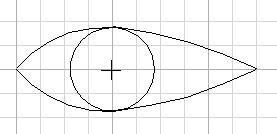 AC 103-7, Appendix 1 drag calculations do not differentiate between strut shapes. Adding fairings to the round tubular FireFly wing struts, one would expect a faster cruise speed and increased endurance and range and remain within AC 103-7 constraints. From a formula found in EAA AIRCRAFT DESIGN, Volume 3, Copyright - 1970,
AC 103-7, Appendix 1 drag calculations do not differentiate between strut shapes. Adding fairings to the round tubular FireFly wing struts, one would expect a faster cruise speed and increased endurance and range and remain within AC 103-7 constraints. From a formula found in EAA AIRCRAFT DESIGN, Volume 3, Copyright - 1970,